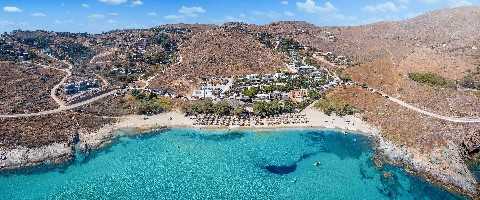Although Kea, also called Tzia, is the closest Cycladic Island to Athens - it is only an hour’s ferry ride from the Attica mainland - it is surprisingly one of the least known and, like its neighbour Kythnos, sees only a fraction of the numbers who flock to the honeypot islands of the central Cycladic group. There are a number of reasons for this - Kea is served only from the minor port of Lavrio; ferry connections with other islands are limited to Kythnos and Syros in the main; and the island has long been a preserve of the well-heeled Athenian crowd who prefer to keep the secret to themselves!
Kea has a very long and distinguished history as evidenced by the Neolithic settlement of Kephala, which dates back to 4500 BC, and Bronze Age Ayia Irini. The archaeological site of Karthea is proof of Kea's importance in classical times, being one of four city states on the island and even producing its own coinage. And the famous Lion of Ioulis, an ancient stone carving close to the capital dates from at least 600 BC - a must-see for every visitor. In more recent times Byzantines, Venetians and Ottomans have all left their mark. So, a visit to the archaeological museum is recommended.
Like most Cycladic islands, Kea boasts fine sandy beaches around its 85 km coastline. The most popular are a cluster in the south west, from Pisses to Kambi, as they can be easily reached by road. Otzias beach in the north is also lovely. These beaches generally have sunbeds for rent during the short summer season here but many do not.
Other than the capital Ioulis (Ioulida), the small port of Korissia and neighbouring Vourkari - known for its seafood restaurants - there are no settlements of any size to speak of. Korissia has a parade of quite smart tavernas, cafes and local shops along its waterfront ‘paralia’ and a sand/shingle beach to the far end. Other beaches can be found in the next couple of bays and 5 kms north brings you to Otzias, a wide sandy bay with a couple of tavernas and a seasonal beach cafe.
Like nearly all Cycladic Island capitals, Ioulis is inland and high above the sea as protection from pirates. It is 5 kms from Korissia (a ten minute drive) and well worth a visit.In addition to the museum and the Lion of Ioulis a short walk outside the village, it has oodles of traditional Greek charm: whitewashed houses with terracotta roofs interspersed by bursts of scarlet bougainvillaea, hidden chapels, narrow lanes, arches, sleepy cats and a shady square or two. Plus, some good tavernas and spectacular views!
Inland Kea reveals a different face - one that will richly reward walkers and nature lovers, especially during springtime and early season when the island is green and carpeted with wild flowers on its upper reaches (Kea’s highest point is 560m). There is a well preserved network of ancient footpaths that linked the four ancient city states, many still stone paved, of which a dozen, totalling 81 kms in length, have been restored and mapped for visitors. These will lead you through beautiful countryside, up hills and down valleys to secluded beaches, ancient monuments and isolated chapels.
There is a small bus network on the island, connecting Korissia with Ioulis and also beaches south (Pisses, Koundoura) and north (Otzias). However, the service is limited outside high season and weekends and, although taxis can be called, we would recommend car hire to explore the island fully. A recent addition is a public e-bike rental network, very handy for shorter journeys. Kea understandably gets very busy during Athenian holiday periods and summer weekends so the visitor will be best rewarded in the quieter months outside July and August.





